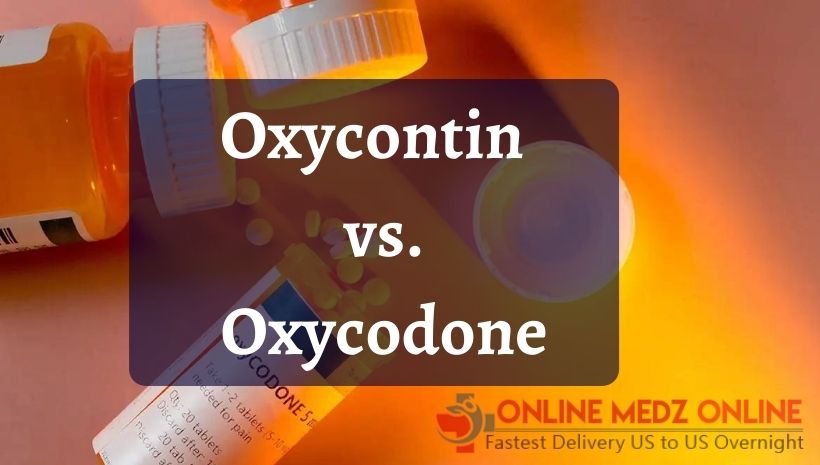
Oxycontin vs. Oxycodone
What are Oxycodone and Oxycontin?
It is a drug that is prescribed for people who have pain. Like other opioid drugs, such as codeine and morphine, it is used to treat pain. Oxycodone, on the other hand, can be found in a lot of different things. It is often used with other drugs.
However, Oxycodone can be used alone or in immediate-release products. Oxycodone is for to treat post-surgery pain, broken bones, chronic pain, and cancer-related pain. It usually comes as an oral tablet by prescription.
Oxycontin is a prescription opioid used to treat pain that non-opioid pain medicines can’t handle. Opioids like Oxycontin can be addictive and even fatal if misused. Every day, over 100 Americans die from opioid overdoses. Learn about Oxycontin use it safely and identify misuse. You can buy Oxycodone without prescription but take safety measures.
Which is stronger: Oxycodone vs. oxycontin?
It’s hard to say which is stronger: Oxycodone vs. OxyContin. It’s a common question because these two things are so well-known. OxyContin and Oxycodone are usually given to patients who need long-term pain relief.
Many people think of Oxycodone as the less powerful drug, but because it is often used with other medications, it is still an opioid drug. While this is true, it is safe to use it with Tylenol or ibuprofen simultaneously. Does this mean that the answer to the question “OxyContin vs. Oxycodone” is “OxyContin,” or that OxyContin is the more potent drug? Not all the time.
OxyContin is more potent because it lasts longer. OxyContin is called a “long-acting” or “extended-release” painkiller because it takes a long time to work. While both are used to treat moderate to severe pain, Oxycodone is usually prescribed for the chronic, intense pain that won’t go away. Oxycontin vs. oxycodone high doses can be dangerous, so keep this in mind.
Which Painkiller is Right for You? Oxycontin vs. Oxycodone?
Oxycodone is an opioid painkiller that is used to treat pain that is moderate to very severe. People who took OxyContin and other pain medications like Tylox said it is an active ingredient. If you take OxyContin, it has Oxycodone, so the Oxycontin generic name “oxycodone” refers to the brand OxyContin. There are essential differences between the two. On the other hand, OxyContin has a time-release mechanism that allows the drug to be released over time. Many people have to take less of the drug because they do this.
Both drugs work by changing how you feel and think about the pain by binding to opioid receptors in your central nervous system. Typical results are that pain is relieved and that you are happy.
OxyContin has more potent effects because it has a more pure concentration of Oxycodone, and the way the drug is made makes it very addictive.
The Dosages of Oxycontin and Oxycodone
Oxycontin (a tablet) is the extended-release version of Oxycodone. The former has a round shape, whereas the latter has a narrower profile filled with yellow to light brown tablets.
The film-coated Oxycontin tablets (controlled-release) are available in doses of 10, 15, 20, 30, 40, 60, and 80 mg per tablet.
It’s up to your doctor to tell you what to do, but the manufacturer says that one tablet every 12 hours (twice a day) is best.
Oral dosage
Adults
People who haven’t used opioids before can take 5 to 15 mg of the drug every four or six hours for pain. People with chronic, severe pain think about taking medicine every 4 to 6 hours. People switching from another opioid treatment should consider how strong the previous drug was compared to Oxycodone when choosing the total daily dose of Oxycodone.
Children (5 years or older)
0.2 mg/kg PO 30 minutes before surgery reduced postoperative pain in children aged 5 to 14. (16.6 kg to 56 kg). Compared to oral fentanyl, the oxycodone doses were higher.
Side Effects of Oxycontin and Oxycodone
Oxycontin’s most common side effects include:
- lightheadedness
- dizziness
- sedation
- nausea
- vomiting
- headache
- rash
- constipation
Side effects of Oxycodone:
- Chills
- cold sweats
- confusion
- difficult or labored breathing
- fever
Precautions: Oxycodone and Oxycontin
Prescribers of Oxycodone are always cautious, and there are several reasons why:
- Respiratory depression: Opioids cause respiratory depression, which causes slower and less effective breathing. People with opiate dependence should not take these drugs.
- Unmonitored bronchial asthma: Related to the above, uncontrolled asthma patients should avoid opioids due to pulmonary inflammation.
- Gastrointestinal obstruction: Oxycodone can also affect the digestive system, so conditions that make it hard to eat, like paralytic ileus, are not good reasons. Some people have pancreatitis, appendicitis, gastroenteritis (the stomach flu), and other things that cause them to have these things.
- Allergy: Some people are allergic to Oxycodone, which can cause anaphylactic shock, a medical emergency that causes trouble breathing, a rash, and wonder.
Do you need a prescription for Oxycodone and Oxycontin?
You need a doctor’s prescription to buy these two drugs. These drugs are frequently laced with heroin or fentanyl to increase their potency and danger. It’s a common misconception that these drugs can be obtained without a prescription. Oxycodone free shipping USA is available in some states.
According to the DEA, OxyContin is abused by opioid addicts due to its high Oxycodone content. The drug is supposed to be released gradually into the body. The medications in Oxycodone enter your bloodstream simultaneously and take effect quickly. It has a three-hour half-life, meaning it won’t work for six hours. Some pharmacies offer Oxycontin overnight delivery to get the medication as soon as possible.
